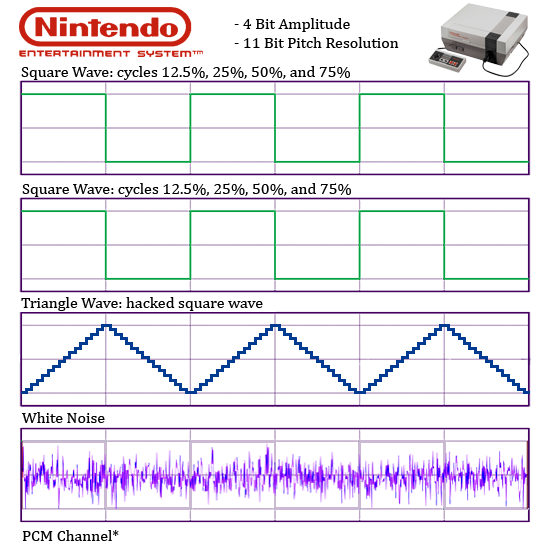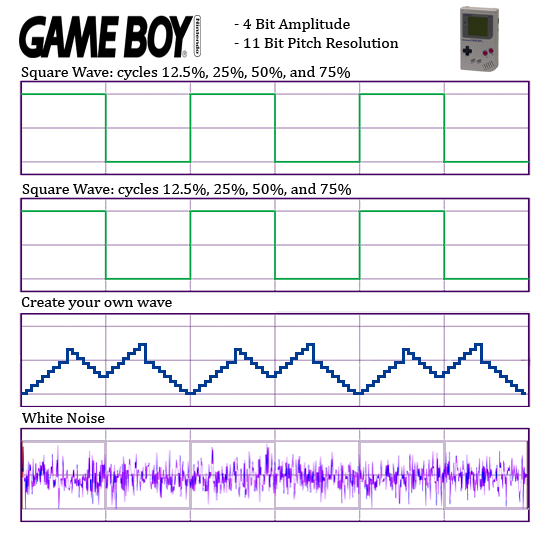Research Information on "Digital Sound and Music in Computer Games"
Source: http://3daudio.info/gamesound/history.html
Importance: Absolutely essential
- 1930 - Baffle Ball, the ancestor to all pinball machines, utilized artificially generated sounds to produce noise
- May 24 1972 - Magnavox Odyssey, the first video game system, featured no sound
- No integrated circuits kept costs low, but no sound
- Huge success though
- June 27 1972 - Atari company formed, tested concept for Pong at a local bar with coin slot
- No music, only made a "pong" sound when the ball hit a paddle
- By the end of 1973, 25 companies were producing games similar to Pong
- 1975 - Atari's home version of Pong became a massive success
- Formed a new industry
- 1972 - Atari released Touch Me, had 4 blinking buttons that the user had to press in the order they blinked
- MB bought the idea and turned into Simon, which had added sound, and it became a huge success
- Signifies importance of sound in electronic entertainment
- 1977 - Atari 2600 release, had a chip named Stella that handled sound
- Stella had 2 audio circuits that could be programmed independently
- 5-bit register means only 32 unique sounds possible
- Sound output could be controlled by volume, pitch, and tone, allowing primitive music to be made (http://3daudio.info/gamesound/files/acid_drop.mp3)
- 1980- First competitor of Atari 2600, Mattel Intellivision, made
- 3 separate sound channels controlled by pitch, volume, and attack/decay patterns
- Also had a noise channel
- 12-bit register meant there were 4096 possible sounds, pitch-perfect songs can be made (http://3daudio.info/gamesound/files/sharkshark.mp3)
- Sound chip in this system used in many later systems
- Had an extension called the Intellivoice, allowing computer-synthesized speech to be played (http://3daudio.info/gamesound/files/mattel.mp3)
- 1978's Space Invaders and 1980's Pac-Man became a worldwide success, introduced electronic video entertainment to many
- 1985 - NES introduced to US after a video game crash in 1983, 1 in every 4 houses had an NES by 1989
- Had no soundchip, analog circuitry controlled sound
- Total of 5 sound channels
- 2 square channels (Produces sound waves that look like squares)
- 1 triangle channel (sound waves look like triangles)
- 1 noise channel
- 1 channel to playback samples (Not used often because samples used up a lot of space at the time)
 |
| Image: http://www.originalsoundversion.com/inverse-phases-music-from-old-sound-chips/ |
- 1987 - NEC TurboGrafx-16 released
- 6 digitized sound channels
- 2 sound channels for ADPCM-compressed samples
- First console to support stereo output
- First console to use a CD-ROM w/ an attachment, allowed developers to to create more realistic music and sounds in games
- 1989 - Nintendo's Game Boy released, innovated portable console market
- 1 channel offering 4-bit sound samples
- 3 PSG (Programmable Sound Generator) channels
- 1 White Noise channel
- 1989 - Sega Genesis/Mega Drive released
- 6 channels powered by a Yamaha synthesizer chip
- 4 channels powered by a PSG chip
- 1991 - Sega CD add-on released,
- Added 8 PCM sound channels to playback recorded sound
- CD-ROM technology and added PCM channels allowed pre-recorded music to be put into games
- 1991 - SNES released
- Had a digital signal processor that can mix up to 8 voices at once and change the pitch and volume of each voice
- Each voice powered by a small pre-recorded instrument sample
- A special program tells the DSP which samples to play and which to alter the pitch/volume of
- Similiar to MIDIs
- 1993 - Panasonic 3DO released
- First CD only console
- 1994 - Soundtrack for game Tempest 2000 was released as a CD to be sold
- First instance of a commercially sold soundtrack for a video game
- 1994 - Sega Saturn released
- 32 channels of CD quality audio (16-bit 44.1kHz)
- Had limitations: Audio samples have to be decompressed to the internal audio memory buffer of 512k before being used, limited quality and/or amount of audio samples that can be played at the same time
- 32 MIDI channels
- 32 channels powered by a Yamaha synthesizer
- 1994 - Sony Playstation released
- 24 channels of CD quality audio
- Allowed for real-time effects (Pitch modulation, digital reverb, amplitude envelopes)
- Support for MIDI
- Audio didn't have to be decompressed like Saturn
- Audio memory buffer of 512kb
- 1996 - Nintendo 64 released
- Unlike other consoles at the time, used cartridges instead of CDs
- Limited storage, usage of sounds and speech can't be as extensive compared to Saturn and Playstation
- No unique audio chip, audio is handled by CPU and other processing chips
- Played 16-bit 48kHz audio
- Number of channels not defined, depends on software
- Filters and effects can be added to sound
- 1998 - Sega Dreamcast released
- Used a GD-ROMs, similar to CD-ROM, but had 1.2 GB storage instead of 700 MB
- Two sound processors create 64 channels of CD-quality sound
- Audio no longer needs to be decompressed before using
- Audio memory buffer of 2 MB
- Allowed for real-time effects to be added
- 2000 - Sony PS2 released
- Used a DVD-ROMs, typically 4.7 GB
- 2 MB sound memory
- Had one soundchip with 48 channels of 16-bit 48kHz audio
- Also supports 8 channels of surround sound, making it the first console with multi-channel surround sound
 |
| Image: http://www.originalsoundversion.com/inverse-phases-music-from-old-sound-chips/ |
This article details the hardware capabilities of important video game systems, and how they affected the ways developers could implement music. This article is very important since it gives a detailed history of the beginnings of sound in video games, the rise of music in them, and eventually the evolution of video game music as the audio capabilities of gaming systems advanced. This is exactly what I need for my investigation. This article also lists various sources on the page http://3daudio.info/gamesound/index.html. This helps boost the reliability of this source since it has proper evidence that it references.
No comments:
Post a Comment